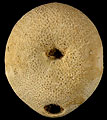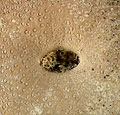The Echinoid Directory
Progonolampas Bittner, 1892, p. 357
| Diagnostic Features |
|
|---|---|
| Distribution | Upper Eocene to Upper Oligocene of Australia and Cuba. |
| Name gender | feminine |
| Type | Progonolampas novae-hollandiae Bittner, 1892, p. 357 [=Echinolampas posterocrassa Gregory, 1890, p. 483]; by original designation. Holotype NHM E3381. |
| Species Included |
|
| Classification and/or Status |
|
| Remarks |
|




